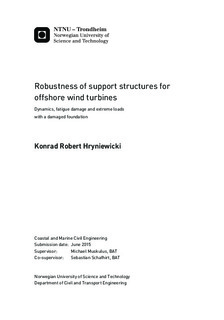Robustness of support structures for offshore wind turbines - Dynamics, fatigue damage and extreme loads with a damaged foundation
Master thesis
Permanent lenke
http://hdl.handle.net/11250/2366139Utgivelsesdato
2015Metadata
Vis full innførselSamlinger
Sammendrag
Abstract
This master thesis considers the strength analysis of the offshore wind turbine s jacket support structure with one structural member damaged or weakened, not capable of transferring the loads. A wind turbine and its substructure are usually exposed to environmental loadings (i.e. wind, waves) and described by computer simulations. FEDEM Windpower environment is used to analyse the model of the offshore wind turbine.Firstly, the thesis is to indicate the areas of the largest fatigue damage accumulation in the remaining structure members and to estimate their ultimate strength. The fatigue evaluation of the steel structure elements is based on the Palmgren-Miner linear damage hypothesis. The steel brace member damage has been modelled by reducing the elastic modulus (Young's modulus) or inserting a free-joint mechanism in the middle of the element. Then the results of structure strength calculations before and after damage are collected and compared.Secondly, the analysis assumes a reduction in the fatigue loads applied to the support structure by changing the wind turbine control system. These changes are aimed at decreasing mainly the rotor revolution frequency and generator torque at the same time. The adjustment is achieved by varying a turbine blade pitch. The controller has also been modified to avoid continuous turbine operation at frequencies close to resonance.
